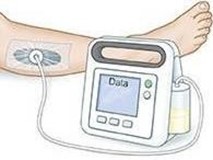Neurodiversity information for parents and young people
About NPWT
NPWT is a treatment that helps wounds heal by delivering negative pressure (a vacuum) to the wound. It does this through special dressings and a therapy machine.
A special dressing is sealed over the wound and a gentle vacuum pump is attached.
Using NPWT means there is less need for daily dressing changes.

How it helps a wound to heal
NPWT works in the following ways.
- It removes fluid that can build up in a wound and delay the healing process.
- It helps take away any germs which might be growing on or in the wound.
- It helps to pull the edges of the wound together and increases blood flow to the wound.
- It provides a sealed environment around your wound. This reduces the risk of wound infection.
How a wound feels if you use NPWT
When the dressing is put onto the wound and the system is first turned on you might feel a slight pulling sensation. Most patients report that this sensation does not last for longer than 15 minutes.
When the dressing is removed it may stick to the wound slightly. Sometimes this causes a little discomfort. Your nurse will apply some water to the dressing, to help them remove it more easily.

Frequently asked questions about using NPWT
Use the drop-down menu for answers to FAQs
How long will I have to use the NPWT system?
NPWT is only effective if it is connected and switched on all day and all night.
If it is turned off during treatment, the wound healing process may be delayed.
The amount of time you use the NPWT system depends on you and your wound. Your healthcare professional will discuss estimated timescales with you.
How often does my dressing need to be changed?
The frequency of dressing changes depends on the size and type of wound.
Most NPWT dressings are changed every 2 to 4 days. Your healthcare professional will discuss this with you.
If your wound becomes infected, your nurse may need to change your dressing more frequently.
It takes around 30 minutes to change the dressing (depending on the size of the wound).
Can I move around while on NPWT?
Your ability to move around depends upon the location of your wound. It also depends on your own level of everyday mobility.
The NPWT machine can be disconnected from the mains power supply and function with a portable battery backup.
Your nurse will show you how to use the portable battery backup.
Can I wash while on NPWT?
Yes. When your nurse applies the dressing they will show you or your carer how to disconnect the machine from the dressing. This allows you to wash.
Is NPWT safe?
NPWT is safe. We use it on a wide variety of wounds.
Thousands of patients have used it and it has helped their wounds to heal.
What happens if the NPWT alarm goes off
The NPWT system has two alarms. One is audible and one is visual. Each alarm describes what is happening to your wound.
If the alarm goes off, the machine will make a beeping sound and the light on top of the machine will turn orange. The machine screen will display a message indicating the problem. For example a leak in the dressing or a low battery alert.
If you are a hospital inpatient, your nurse will explain how the alarm might be triggered.
If you are discharged home with NPWT, your healthcare professional will give you a list of things that might trigger an alarm.
Important
Contact your hospital nurse, district nurse or GP practice nurse immediately if:
- You notice an obvious change in colour or thickness of the fluid draining from the wound.
- You notice bleeding from the wound.
- You notice that the skin around the wound becomes red and more inflamed or that it smells.
- You experience an increased level of pain.
- The NPWT alarm will not stop going off.
- The NPWT has been turned off for more than two hours.
If you do not want to use NPWT
If you do not want to use NPWT, tell your nurse or healthcare professional. They will give your wound an ordinary dressing instead.
Contact information
Kingston Hospital Tissue Viability Team, Monday to Wednesday 7.30am to 5.30pm and Thursday to Friday, 7.30am to 4pm